Alevel化学题
2011年alevel化学真题13

∆H = +53 kJ mol–1
Which change of conditions will cause the purple colour of the equilibrium mixture to become paler?
A decrease in pressure B decrease in temperature C increase in pressure D increase in temperature
104°
N CO HC
3
109°
N CO H3C
120°
H3C N C O 180°
6 When chlorine and aqueous sodium hydroxide are heated together the following overall reaction occurs.
3Cl 2(aq) + 6NaOH(aq) → 5NaCl (aq) + NaCl O3(aq) + 3H2O(l)
At which temperature and pressure would the behaviour of chlorine become more ideal?
pressure temperature
/ kPa
/K
A
50
200
B
50
400
C
200
200
D
200
400
5 Methyl isocyanate, CH3NCO, is a toxic liquid which is used in the manufacture of some pesticides.
2019年alevel化学真题5卷答案——国际考生必看
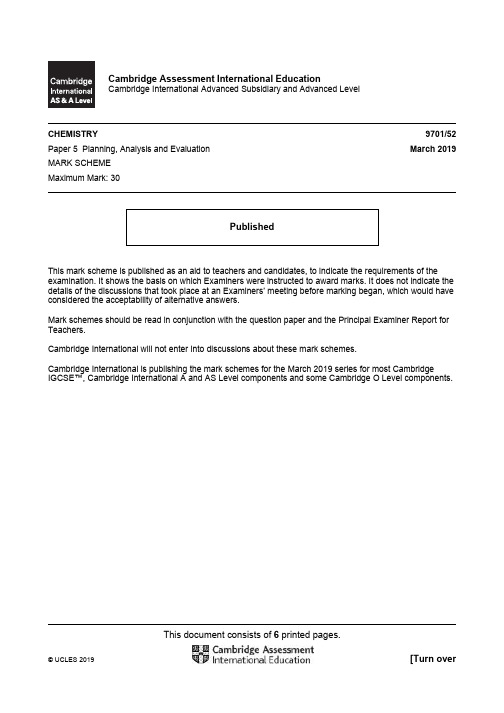
This document consists of 6 printed pages.© UCLES 2019[Turn overCambridge Assessment International EducationCambridge International Advanced Subsidiary and Advanced LevelCHEMISTRY9701/52 Paper 5 Planning, Analysis and Evaluation March 2019MARK SCHEME Maximum Mark: 30PublishedThis mark scheme is published as an aid to teachers and candidates, to indicate the requirements of the examination. It shows the basis on which Examiners were instructed to award marks. It does not indicate the details of the discussions that took place at an Examiners’ meeting before marking began, which would have considered the acceptability of alternative answers.Mark schemes should be read in conjunction with the question paper and the Principal Examiner Report for Teachers.Cambridge International will not enter into discussions about these mark schemes.Cambridge International is publishing the mark schemes for the March 2019 series for most CambridgeIGCSE™, Cambridge International A and AS Level components and some Cambridge O Level components.Generic Marking PrinciplesThese general marking principles must be applied by all examiners when marking candidate answers. They should be applied alongside the specific content of the mark scheme or generic level descriptors for a question. Each question paper and mark scheme will also comply with these marking principles.GENERIC MARKING PRINCIPLE 1:Marks must be awarded in line with:•the specific content of the mark scheme or the generic level descriptors for the question•the specific skills defined in the mark scheme or in the generic level descriptors for the question•the standard of response required by a candidate as exemplified by the standardisation scripts.GENERIC MARKING PRINCIPLE 2:Marks awarded are always whole marks (not half marks, or other fractions).GENERIC MARKING PRINCIPLE 3:Marks must be awarded positively:•marks are awarded for correct/valid answers, as defined in the mark scheme. However, credit is given for valid answers which go beyond the scope of the syllabus and mark scheme, referring to your Team Leader as appropriate•marks are awarded when candidates clearly demonstrate what they know and can do•marks are not deducted for errors•marks are not deducted for omissions•answers should only be judged on the quality of spelling, punctuation and grammar when these features are specifically assessed by the question as indicated by the mark scheme. The meaning, however, should be unambiguous.GENERIC MARKING PRINCIPLE 4:Rules must be applied consistently e.g. in situations where candidates have not followed instructions or in the application of generic level descriptors.© UCLES 2019 Page 2 of 6GENERIC MARKING PRINCIPLE 5:Marks should be awarded using the full range of marks defined in the mark scheme for the question (however; the use of the full mark range may be limited according to the quality of the candidate responses seen).GENERIC MARKING PRINCIPLE 6:Marks awarded are based solely on the requirements as defined in the mark scheme. Marks should not be awarded with grade thresholds or grade descriptors in mind.© UCLES 2019 Page 3 of 61(a)(i) M1 moles needed 0.100 × 250 / 1000 = 0.025(0) mol2 M2 M1 × 166.0 = 4.15 g1(a)(ii) (Re)weigh the empty weighing boat (and the difference should be 4.15 g) 1 1(a)(iii) M1(pour using a funnel and) rinse the beaker with (distilled) water2 M2add (distilled) water dropwise near the mark1(b) the solution in the burette is at the expected concentration 1 1(c) 12.50 (cm3) 1 1(d)(i) step4 1 1(d)(ii) the recorded times are repeatable / the recorded times can be duplicated / the repeated times are close to one another 1 1(d)(iii) 0.5(00)% 1 1(d)(iv) acid is in excess 1 1(d)(v) M1independent: (relative) concentration of K I / (relative) concentration of I–2 M2dependent: time (taken)© UCLES 2019 Page 4 of 61(e)(i)2v t av / s (1 / t av) / s–1 log(1 / t av)v / cm3 log5.00 0.699 219 0.00457 –2.3410.00 1.00 113 0.00885 –2.0512.50 1.10 100 0.0100 –2.0015.00 1.18 76.5 0.0131 –1.8820.00 1.30 59.0 0.0169 –1.7725.00 1.40 48.0 0.0208 –1.68M1column 3 and column 6 mathematically correctM2column 3 and column 6 to 3 sf1(e)(ii) M1 points plotted2 M2line of best fit1(e)(iii) M1 correct co-ordinates3 M2correct gradient (to 3 sf)M3 first order© UCLES 2019 Page 5 of 62(a) Ag+(aq) + C l–(aq) → AgC l(s) 1 2(b)(i) M1(buchner) funnel (with filter paper)2 M2sealed with a cork around the funnel2(b)(ii) increased rate (of filtration) 1 2(c)(i) warm / heat to constant mass 1 2(c)(ii) (5.736 g AND 5.736 / 143.4 =) 0.04(00) 1 2(c)(iii) M1 mol of MC l2 = 0.04 / 2 = 0.02(00)3 M2molar mass of MC l2 = 3.172 / 0.02 = 158.6M3A r of M = 158.6 – 71.0 = 87.6 and Sr2(c)(iv) increase because tap water contains chloride ions 1© UCLES 2019 Page 6 of 6。
2021年浙江省杭州市常春藤A-Level国际高中高二化学上学期期末试卷含解析

2021年浙江省杭州市常春藤A-Level国际高中高二化学上学期期末试卷含解析一、单选题(本大题共15个小题,每小题4分。
在每小题给出的四个选项中,只有一项符合题目要求,共60分。
)1. 某醇和醛的混合物0.05 mol,能从足量的银氨溶液中还原出16.2 g银,已知该醇为饱和一元醇,该醛的组成符合C n H2n O,下列结论正确的是A.此混合物中的醛一定不是甲醛B.此混合物中的醛、醇可以是任意比C.此混合物中的醇、醛的物质的量之比是1︰1D.此混合物中的醇、醛的物质的量之比是1∶3 参考答案:D略2. 能直接与硝酸银溶液作用产生沉淀的物质是A.氢溴酸 B.氯苯 C.溴乙烷 D.四氯化碳参考答案:A3. 油脂水解后的一种共同产物是A.硬脂酸 B.软脂酸 C.甘油 D.油酸参考答案:C略4. 下列化学用语或模型表达正确的是A.8个中子的碳原子的核素符号:B.H2 O电子式:C.Cl一的结构示意图: D.CH4分子的比例模型:参考答案:略5. 酒后驾车是引发交通事故的重要原因。
交警对驾驶员进行呼气酒精检测的原理是:橙色的K2Cr2O7酸性水溶液遇乙醇迅速生成蓝绿色的Cr3+。
下列对乙醇的描述与此测定原理有关的是①乙醇沸点低②乙醇密度比水小③乙醇有还原性④乙醇是烃的含氧衍生物A.②④B.②③C.①③D.①④参考答案:C略6. 若不断地升高温度,实现“雪花→水→水蒸气→氧气和氢气”的变化。
在变化的各阶段被破坏的粒子间的主要相互作用依次是()A.氢键;分子间作用力;非极性键B.氢键;氢键;极性键C.氢键;极性键;分子间作用力D.分子间作用力;氢键;非极性键参考答案:B略7. 下列关于苯的说法正确的是A. 苯不能发生加成反应B. 能与溴水反应而褪色C. 苯存在单双键交替结构D. 一定条件下能与液溴发生取代反应参考答案:DA. 苯能发生加成反应,A错误;B. 苯能与液溴反应,与溴水发生萃取,B错误;C. 苯不存在单双键交替结构,C错误;D. 一定条件下苯能与液溴发生取代反应生成溴苯和溴化氢,D正确,答案选D。
chapter 7 redox reaction氧化还原反应alevel化学CIE
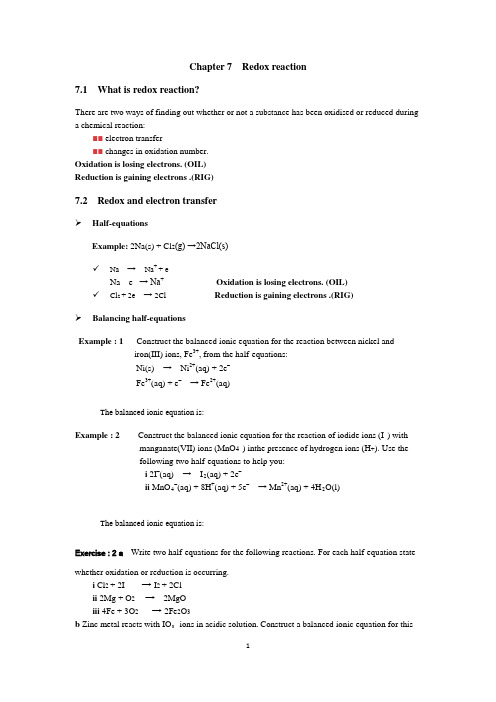
Chapter 7 Redox reaction7.1 What is redox reaction?There are two ways of finding out whether or not a substance has been oxidised or reduced during a chemical reaction:■■ electron transfer■■ changes in oxidation number.Oxidation is losing electrons. (OIL)Reduction is gaining electrons .(RIG)7.2 Redox and electron transferHalf-equationsExample: 2Na(s) + Cl2(g) →2NaCl(s)✓Na → Na++ e–Na – e– → Na+ Oxidation is losing electrons. (OIL)✓Cl2 + 2e– → 2Cl– Reduction is gaining electrons .(RIG)Balancing half-equationsExample : 1 Construct the balanced ionic equation for the reaction between nickel and iron(III) ions, Fe3+, from the half-equations:Ni(s) →Ni2+(aq) + 2e–Fe3+(aq) + e–→ Fe2+(aq)The balanced ionic equation is: ___________________________________________________Example : 2 Construct the balanced ionic equation for the reaction of iodide ions (I–) with manganate(VII) ions (MnO4–) inthe presence of hydrogen ions (H+). Use thefollowing two half-equations to help you:i 2I–(aq) →I2(aq) + 2e–ii MnO4–(aq) + 8H+(aq) + 5e–→ Mn2+(aq) + 4H2O(l)The balanced ionic equation is: ___________________________________________________Exercise : 2 a Write two half-equations for the following reactions. For each half-equation statewhether oxidation or reduction is occurring.i Cl2 + 2I– → I2 + 2Cl–ii 2Mg + O2→ 2MgOiii 4Fe + 3O2 → 2Fe2O3b Zinc metal reacts with IO3– ions in acidic solution.Construct a balanced ionic equation for thisreaction, using the two half-equations below:2IO3– + 12H+ + 10e– → I2 + 6H2OZn → Zn2+ + 2e–7.3 Oxidation numbersWhat are oxidation numbers(oxidation states)?Oxidising agent &reducing agentOxidation number rules1.单质化合价均为0.2.在化合物中,许多原子有固定化合价--第一主族(_________________________________________)元素为+1价--第二主族(_________________________________________)元素为+2价--氟元素(F)总为-1价--氢元素(H)为+1价(除非为金属氢化物,如NaH, H为-1 )--氧元素(O)为-2 价(过氧化物peroxide中的氧为-1,F2O中氧为+2)3. 化合物中各元素化合价之和为0.4. 离子团的化合价之和等于离子的带电荷数。
alevel2024春季考试试题

alevel2024春季考试试题Alevel 2024春季考试试题随着2024春季的到来,学生们正忙于备考Alevel考试。
Alevel考试是英国高中生的重要考试,对于学生们进入大学或职业生涯具有重要的影响。
为了帮助同学们更好地准备考试,我们整理了一套2024春季考试试题,希望能对大家有所帮助。
1. 英语(English)1.1 阅读理解(Reading Comprehension)阅读下面一篇短文,然后回答问题。
文章:...问题:...解答:...1.2 写作(Writing)请根据以下提示,写一篇关于环境保护的短文。
提示:...内容:...结论:...2. 数学(Mathematics)2.1 代数(Algebra)解以下方程组。
解答:...2.2 几何(Geometry)计算以下几何问题。
问题:...解答:...3. 物理(Physics)3.1 力学(Mechanics)问题:...解答:...3.2 电学(Electronics)问题:...解答:...4. 化学(Chemistry)4.1 有机化学(Organic Chemistry)问题:...解答:...4.2 物质与变化(Matter and Change)问题:...5. 生物(Biology)5.1 分子生物学(Molecular Biology)问题:...解答:...5.2 生态学(Ecology)问题:...解答:...以上是2024春季考试的试题,希望能为同学们的备考提供一定的帮助。
在备考过程中,同学们应该注重理论的学习和实践的练习,努力提高自己的知识水平和应试能力。
在英语考试中,阅读理解是一个重要的部分。
同学们需要通过大量的阅读来提高自己的理解能力,同时掌握一些阅读技巧,如寻找关键词,理解上下文等。
在写作方面,同学们应该注重语法和词汇的准确性,同时注意文章的结构和逻辑性。
在数学考试中,代数和几何是重点。
同学们需要熟练掌握代数的基本运算和方程的解法,同时理解几何的基本概念和定理。
alevel 化学 题型

alevel 化学题型
A-Level化学的题型包括选择题、填空题、简答题和实验题。
1. 选择题:这是最常见的题型,要求考生从给定的选项中选择正确答案。
2. 填空题:这种题型要求考生填写缺失的单词或短语,通常涉及到一些基础知识的记忆。
3. 简答题:简答题要求考生用简短的语言回答问题,通常涉及到对概念的理解和解释。
4. 实验题:这种题型要求考生设计和进行实验,通常涉及到对实验原理、实验步骤和实验结果的分析和解释。
希望以上信息对你有帮助,具体考试内容和题型可能会根据考试大纲有所变化,建议咨询相关人员。
历年A-level化学试题的发展研究

历年A-level化学试题的发展研究作者:王春姣来源:《化学教学》2016年第05期摘要:A-Level课程是英国的全民课程,A-Level考试也是英国学生的大学入学考试,类似于我国的高考。
本文结合对A-Level化学考试评价目标、评价方案、考试内容的介绍,分析近五年A-Level化学考试试题特点,以期为我国基础教育阶段化学教学提供一些参考和借鉴。
关键词:A-Level化学考试;试题研究;比较研究;实验技能文章编号:1005–6629(2016)5–0091–04 中图分类号:G633.8 文献标识码:BA-Level课程是英国的普通中等教育证书考试高级水平课程,其权威性得到了国际上的广泛认可。
A-Level考试类似于我国的高考,其考试成绩“在世界范围内被接受作为进入大学的学术能力证明”[1]。
1 A-Level化学考试简介1.1 评价目标A-Level化学学科为“学习化学或者是高等教育课程的人提供了一个很合适的平台”,并且能“更加直接有效地让学生接受大学的化学课程或者是其他学科的学习”[2]。
其化学考试评价目标有“知识的理解”、“处理、应用和评价信息”、“实验技能与探究”三个维度。
其评价目标的各个维度在考试中所占的比重是不同的,其中“知识的理解”目标维度所占权重为46%,“处理、应用和评价信息”目标维度所占权重为30%,“实验技能与探究”目标维度所占权重为24%。
值得注意的是A-Level考试对学生实践能力的评价(包括“处理、应用和评价信息”和“实验技能与探究”)权重达到54%,大于对“知识的理解”。
因此,A-Level化学考试不是一个简单的知识考试,而是以考查学生实践能力为主的学科考试。
1.2 评价方案A-Level课程分为AS和A2两部分,在高中前阶段开设基础必修课AS,夯实学科基础,在高中后阶段开设高级选修课程A2。
A-Level考试“形式灵活多样”[3],具体实施方案见表1。
这种考试方式,更注重对学生的相关学科学习是否达到课程标准的要求的考查,更注重对学生学科知识水平的考查,而不仅仅是选拔性的考查。
electronegativity电负性alevel化学
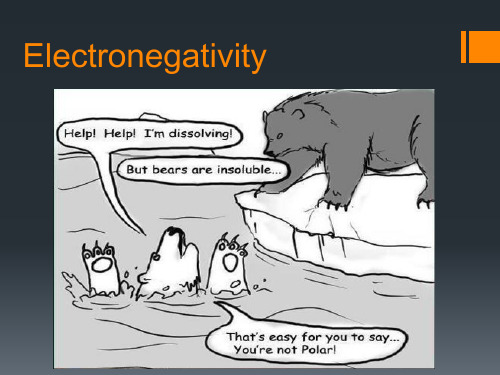
▪Permanent Dipole-dipole force between two polar molecules; stronger force (ex: HCl)
▪ Hydrogen bond forms between the hydrogen end of one dipole and fluorine, oxygen, or nitrogen (that have at least one lone pair) end of another dipole; strongest force (ex: H2O)
A dipole is represented by a dipole arrow pointing towards the more negative end
Is it Polar?
▪HF ▪H2O ▪NH3 ▪CHF3 ▪CO2
Guide to Determination of Polarity of a Molecule
Note
▪fluorine is the most electronegative element
▪Carbon and hydrogen have similar electronegativities that are lower than those of most other non-metallic elements.
molecules
1) CH4
1) polar
2) HCl
2) polar
3) NaF
3) ionic
4) MgCl2 5) SO2 6) NH3 7) H2O 8) KCl
4) ionic 5) polar 6) polar 7) polar 8) ionic
alevel 化学题目
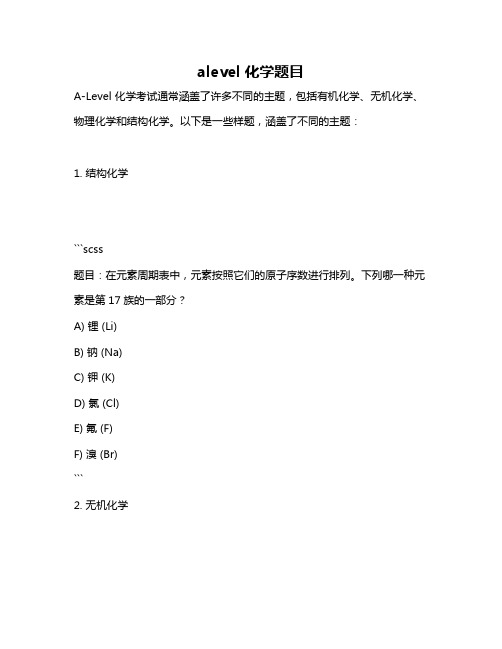
alevel 化学题目A-Level 化学考试通常涵盖了许多不同的主题,包括有机化学、无机化学、物理化学和结构化学。
以下是一些样题,涵盖了不同的主题:1. 结构化学```scss题目:在元素周期表中,元素按照它们的原子序数进行排列。
下列哪一种元素是第17族的一部分?A) 锂 (Li)B) 钠 (Na)C) 钾 (K)D) 氯 (Cl)E) 氟 (F)F) 溴 (Br)```2. 无机化学```scss题目:在化学反应中,物质常常以离子形式存在。
以下哪个离子可以在水溶液中稳定存在?A) Ba(OH)2B) NaHSO4C) Al(OH)3D) H2CO3E) Mg(NO3)2```3. 有机化学```scss题目:在有机化学中,醇是一种常见的化合物,它具有一个氧原子和一个烃基链接在一个碳原子上。
以下哪个化合物是醇?A) CH3CH2OHB) CH3COOHC) CH3OCH3D) HCOOHE) CH3COOCH3```4. 物理化学```scss题目:在化学反应中,能量可以从一种形式转化为另一种形式。
以下哪种能量形式可以在化学反应中被转化?A) 电能B) 热能C) 光能D) 机械能E) 核能```以上样题覆盖了A-Level化学考试的一些主要主题。
要准备这种考试,你需要对化学有深入的理解,包括元素的性质、化合物的结构、化学反应的机制以及能量的转化等。
此外,你需要能够理解和应用相关的数学模型和概念,如原子模型、分子模型、化学键、酸碱反应等。
2021年浙江省杭州市常春藤A-Level国际高中高三化学上学期期末试卷含解析

2021年浙江省杭州市常春藤A-Level 国际高中高三化学上学期期末试卷含解析一、单选题(本大题共15个小题,每小题4分。
在每小题给出的四个选项中,只有一项符合题目要求,共60分。
)1. 已知X 、Y 、Z 、W 、R 是原子序数依次增大的短周期主族元素,X 是周期表中原子半径最小的元素,Y 元素的最高正价与最低负价绝对值相等,Z 的核电荷数是Y 的2倍,W 最外层电子数是最内层电子3倍。
下列说法正确的是A .原子半径:R>W>ZB .氢化物的热稳定性:W>RC .W 与X 、W 与Z 形成的化学键类型完全相同D .最高价氧化物对应的水化物酸性:W>Y参考答案: D 略 2.下列所列各组物质中,物质之间通过一步反应就能实现如图所示转化的是参考答案:B【解析】A 项:(或者,(),(),的转化必须经过(反应方程式为:)和()这两步,所以A 项不选; B 项:(),(),(),(),所以B 项正确; C 项:(),必须经过两步(和),D 项:(),(),(),就必须经过两步(和)3. 下列实验装置、选用的试剂或实验操作中,都正确的是A .实验室用装置A 制取氨气B .用B 装置吸收氨气,并防止倒吸C.用C装置稀释浓硫酸D.用D装置除去CO2中的HCl参考答案:B试题分析:A.实验室利用熟石灰和氯化铵加热制备氨气,A错误;B.氨气极易溶于水,额用B装置吸收氨气,并防止倒吸,B正确;C.稀释浓硫酸应该在烧杯中进行,不能用量筒,C错误;D.碳酸钠溶液也吸收CO2,应该用饱和的碳酸氢钠溶液除去CO2中的HCl,D错误,答案选B。
4.参考答案:C5. 我国科学家成功研发了甲烷和二氧化碳的共转化技术,利用分子筛催化剂高效制得乙酸,下列有关说法正确的是()A.消耗22.4 LCO2可制得1mol乙酸B.该反应属于取代反应C.反应物和生成物中均含有极性键和非极性键D.该反应过程符合“绿色化学”原理,其原子利用率为100%参考答案:D【考点】取代反应与加成反应;绿色化学;极性键和非极性键.【分析】A.未注明是否标准状况;B.取代反应是有机化合物分子里的某些原子或原子团被其它原子或原子团所代替的反应;C.同种元素之间形成非极性共价键,不同元素之间形成极性共价键;D.反应物全部转化为生成物.【解答】解:A.未注明是否标准状况,气体的摩尔体积不知,无法计算,故A错误;B.甲烷和二氧化碳制得乙酸,方程式为:CO2+CH4→C2H4O2,属于化合反应,不是取代反应,故B 错误;C.甲烷只含有C﹣H极性键,二氧化碳中只含有C=O极性键,没有非极性键,故C错误;D.该反应为化合反应,反应物全部转化为生成物,原子利用率达100%,符合“绿色化学”原理,故D 正确.故选D.【点评】本题主要考查了共价键、气体摩尔体积、反应类型、绿色化学等,题目涉及的知识点较多,侧重基础知识的考查,难度不大.6. A、B、C、D四种有机物,它们的分子中均含有2个碳原子,其中A和C是烃,A对氢气的相对密度是15,B和D含相同官能团,D为二元取代物。
alevel化学中前三章的相关练习题

第一章原子结构1(2008) Use of the Data Booklet is relevant to this question. The graph represents the variation of a property of the Group II elements.What is this property?A ionic radiusB ionisation energyC neutron / proton ratioD rate of reaction with water2 (2008)In which pair do both atoms have one electron only in an s orbital in their ground states?A Ca, ScB Cu, BeC H, HeD Li, CrUse of the Data Booklet is relevant to this question.Hard water contains calcium ions and hydrogencarbonate ions arising from dissolved calcium hydrogencarbonate, Ca(HCO3)2.How many electrons are present in the hydrogencarbonate anion?A 30B 31C 32D 333(2010) Use of the Data Booklet is relevant to this question. What could be the proton number of an element that has three unpaired electrons in each of its atoms?A 5B 13C 15D 214(2008)(2010)(a) The diagram below represents the energy levels of the orbitals present in atoms of the second period (Li to Ne).(i) Label the energy levels to indicate the principal quantum number and the type of orbital at each energy level.(b)(2010)(i) Use the Data Booklet to state the value of the first ionisation energy of nitrogen and of oxygen.N ........................... kJ mol–1O ....................... kJ m–1(ii) Explain, with reference to your answer to (a)(iii), the relative values of these two ionisation energies.(a)On the axes below, sketch the shapes of a 1s, a 2s, and a 2px orbital.(2008)The Periodic Table we currently use is derived directly from that proposed by Mendeleev in 1869 after he had noticed patterns in the chemical properties of the elements he had studied.The diagram below shows the first ionisation energies of the first 18 elements of the Periodic Table as we know it today(a) Give the equation, including state symbols, for the first ionisation energy of fluorine. ...................................................................................................................... .(b) Explain why there is a general increase in first ionisation energies from sodium to argon. .......................................................................................................................(c) (i) Explain why the first ionisation energy of aluminium is less than that of magnesium.............................(ii) Explain why the first ionisation energy of sulphur is less than that of phosphorus................................第二章,原子分子和化学计量法(2009)2(2009)0.200 mol of a hydrocarbon undergo complete combustion to give 35.2 g of carbon dioxide and 14.4 g of water as the only products .What is the molecular formula of the hydrocarbon?A C2H4B C2H6C C4H4D C4H83(2008)Use of the Data Booklet is relevant to this question. Titanium(IV) oxide, TiO2, is brilliantly white and much of theoxide produced is used in the manufacture of paint.What is the maximum amount of TiO2 obtainable from 19.0 tonnes of the ore ilmenite, FeTiO3?A 10.0 tonnesB 12.7 tonnesC 14.0 tonnesD 17.7 tonnes 4(2008)In the Basic Oxygen steel-making process the P4O10 impurity is removed by reacting it with calcium oxide. The only product of this reaction is the salt calcium phosphate, Ca3(PO4)2.In this reaction, how many moles of calcium oxide react with one mole of P4O10?A 1B 1.5C 3D 65(2008)Use of the Data Booklet is relevant to this question.A typical solid fertiliser for use with household plants and shrubs contains the elements N, P, and K in the ratio of 15 g : 30 g :15 g per 100 g of fertiliser. The recommended usage of fertiliser is 14 g of fertiliser per 5 dm3 of water.What is the concentration of nitrogen atoms in this solution?A 0.03 mol dm–3B 0.05 mol dm–3C 0.42 mol dm–3–3D 0.75 mol dm(c) In a redox reaction, 0.83 g of lithium reacted with water toform 0.50 dm3 of aqueous lithium hydroxide.2Li(s) + 2H2O(l) 2LiOH(aq) + H2(g)(i) Calculate the amount, in moles, of lithium that reacted. …………………………………………………………(ii) Calculate the volume of hydrogen produced at room temperature and pressure………………(iii) Calculate the concentration, in mol dm–3, of the LiOH(aq) formed……………………第三章化学键和化学结构1(2007)This question is about the bonding of covalent compounds. (b) Covalent bonding occurs when two atoms share a pair of electrons. Covalent bonding may also be described in terms of orbital overlap with the formation of σbonds.(i) How are the two atoms in a covalent bond held together? In your answer, state which particles are attracted to one another and the nature of the force of attraction. ...................................................................................................................... .(ii) Draw sketches to show orbital overlap that produces the σbonding in the H2 and HCl molecules.(c) The bond in the HCl molecule is said to be ‘polar’.(i) What is meant by the term bond polarity?...................................................................................................................... (ii) Explain why the HCl molecule is polar.(2010)Copper, proton number 29, and argon, proton number 18, are elements which have different physical and chemical properties.In the solid state, each element has the same face-centred cubic crystal structure which is shown below.The particles present in such a crystal may be atoms, molecules, anions or cations. In thediagram above, the particles present are represented by .(a) Which types of particle are present in the copper and argon crystals?In each case, give their formula. element particle formulaCopper----------------------------------Argon------------------------------------[2]At room temperature, copper is a solid while argon is a gas.(b) Explain these observations in terms of the forces present in each solid structure.-----------------------------------------------------------------(2008)(2008)201(2010)1 Elements and compounds which have small molecules usually exist as gases or liquids.(a) Chlorine, Cl 2, is a gas at room temperature whereas bromine, Br 2, is a liquid under the same conditions.Explain these observations. (2)(b) The gases nitrogen, N2, and carbon monoxide, CO, are isoelectronic,that is they have the same number of electrons in their molecules. Suggest why N2 has a lower boiling point than CO. (2)(c) A ‘dot-and-cross’ diagram of a CO molecule is shown below. Only electrons from outer shells are representedIn the table below, there are three copies of this structure. On the structures, draw a circle round a pair of electrons that is associated with each of the following.(d) Hydrogen cyanide, HCN, is a gas which is also isoelectronic with N2 and with CO.Each molecule contains a strong triple bond with the following bond energies.Although each compound contains the same number of electrons and a strong triple bond in its molecule, CO and HCN are both very reactive whereas N2 is not.Suggest a reason for this. ...................................................................................................。
ALEVEL化学
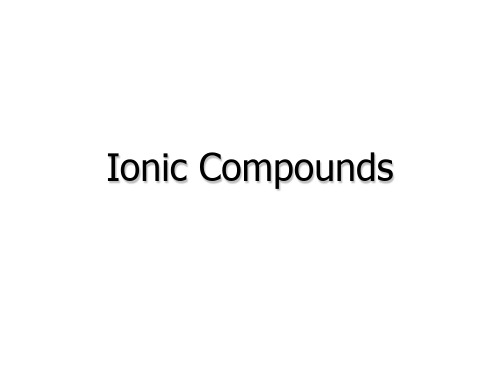
…Memorize them, or
…Look at the periodic table!
Guess which is easier?!
You Guessed it! The “representative” elements are easy!
+1 +2 +3
14
0
-3 -2 -1
Each family has its own charge! Noble gas “wannabe’s”, remember?
Potassium phosphate
Zn(MnO4)2Zinc permanganate CuClO3 Pb(OH)2 Copper (I) chlorate Lead (II) hydroxide
Writing the Formula of a Compound That Contains Polyatomic Ions
Type 2: Ionic Compounds Containing “Polyatomic Ions”
•Polyatomic ions are GROUPS of atoms with a charge! (most will have a negative (-) charge, just like a non-metal ion) You will be given a list of these to use…
Polyatomic Ions
• “poly” means “many”, so…
• “polyatomic” means “many atoms”!
• (These are ions made of groups of atoms)! An example: the polyatomic ion, “nitrate”…
alevel试题及答案
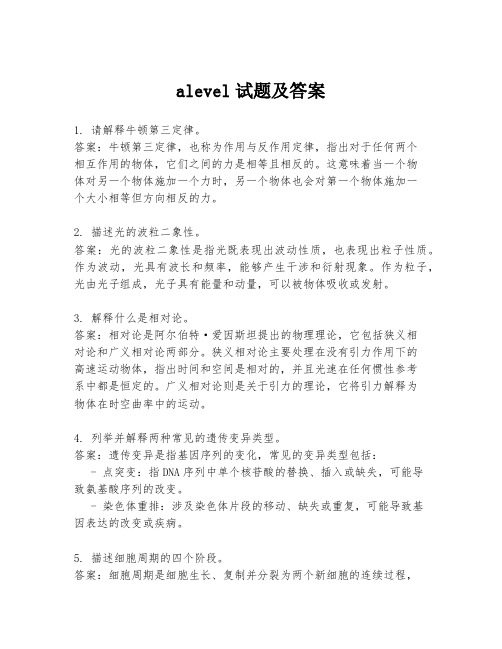
alevel试题及答案1. 请解释牛顿第三定律。
答案:牛顿第三定律,也称为作用与反作用定律,指出对于任何两个相互作用的物体,它们之间的力是相等且相反的。
这意味着当一个物体对另一个物体施加一个力时,另一个物体也会对第一个物体施加一个大小相等但方向相反的力。
2. 描述光的波粒二象性。
答案:光的波粒二象性是指光既表现出波动性质,也表现出粒子性质。
作为波动,光具有波长和频率,能够产生干涉和衍射现象。
作为粒子,光由光子组成,光子具有能量和动量,可以被物体吸收或发射。
3. 解释什么是相对论。
答案:相对论是阿尔伯特·爱因斯坦提出的物理理论,它包括狭义相对论和广义相对论两部分。
狭义相对论主要处理在没有引力作用下的高速运动物体,指出时间和空间是相对的,并且光速在任何惯性参考系中都是恒定的。
广义相对论则是关于引力的理论,它将引力解释为物体在时空曲率中的运动。
4. 列举并解释两种常见的遗传变异类型。
答案:遗传变异是指基因序列的变化,常见的变异类型包括:- 点突变:指DNA序列中单个核苷酸的替换、插入或缺失,可能导致氨基酸序列的改变。
- 染色体重排:涉及染色体片段的移动、缺失或重复,可能导致基因表达的改变或疾病。
5. 描述细胞周期的四个阶段。
答案:细胞周期是细胞生长、复制并分裂为两个新细胞的连续过程,包括以下四个阶段:- G1期:细胞生长和准备DNA复制。
- S期:DNA复制。
- G2期:细胞继续生长,准备进行有丝分裂。
- M期:有丝分裂发生,细胞分裂为两个新的细胞。
6. 解释什么是热力学第一定律。
答案:热力学第一定律,也称为能量守恒定律,指出在一个封闭系统中,能量不能被创造或消灭,只能从一种形式转换为另一种形式。
在热力学过程中,系统吸收的热量等于系统内能的增加和对外做的功之和。
7. 列举并解释两种常见的生态系统服务。
答案:生态系统服务是指生态系统为人类社会提供的直接或间接利益,包括:- 生物多样性保护:生态系统通过维持物种多样性,有助于保持生态平衡和生态系统的稳定性。
alevel 化学题目
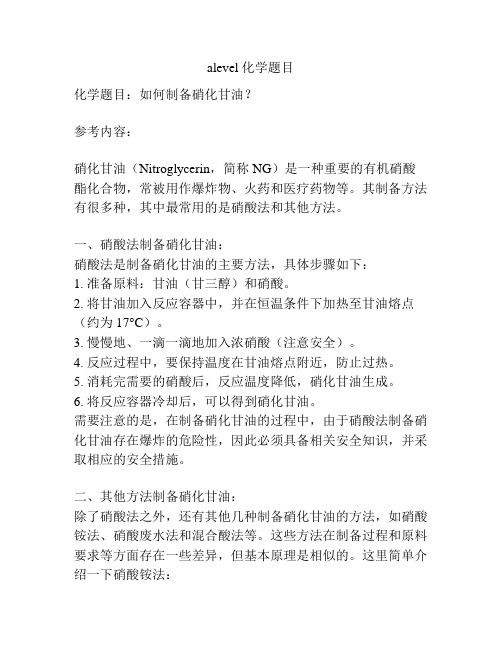
alevel 化学题目化学题目:如何制备硝化甘油?参考内容:硝化甘油(Nitroglycerin,简称NG)是一种重要的有机硝酸酯化合物,常被用作爆炸物、火药和医疗药物等。
其制备方法有很多种,其中最常用的是硝酸法和其他方法。
一、硝酸法制备硝化甘油:硝酸法是制备硝化甘油的主要方法,具体步骤如下:1. 准备原料:甘油(甘三醇)和硝酸。
2. 将甘油加入反应容器中,并在恒温条件下加热至甘油熔点(约为17°C)。
3. 慢慢地、一滴一滴地加入浓硝酸(注意安全)。
4. 反应过程中,要保持温度在甘油熔点附近,防止过热。
5. 消耗完需要的硝酸后,反应温度降低,硝化甘油生成。
6. 将反应容器冷却后,可以得到硝化甘油。
需要注意的是,在制备硝化甘油的过程中,由于硝酸法制备硝化甘油存在爆炸的危险性,因此必须具备相关安全知识,并采取相应的安全措施。
二、其他方法制备硝化甘油:除了硝酸法之外,还有其他几种制备硝化甘油的方法,如硝酸铵法、硝酸废水法和混合酸法等。
这些方法在制备过程和原料要求等方面存在一些差异,但基本原理是相似的。
这里简单介绍一下硝酸铵法:1. 准备原料:甘油和硝酸铵。
2. 将甘油和硝酸铵混合,加热至一定温度。
3. 随着温度的升高,甘油和硝酸铵反应生成硝化甘油。
4. 最后,冷却后可以得到硝化甘油。
总结:硝化甘油是一种重要的化学品,具有广泛的应用。
其制备方法有很多种,其中硝酸法是最常用的,其他方法包括硝酸铵法、硝酸废水法和混合酸法等。
在制备硝化甘油的过程中,需要注意安全,并按照正确的操作步骤进行操作。
同时,还需要熟悉相关的化学知识,了解化学反应原理。
在实际操作中,还需要注意控制温度、控制反应速率等,以保证制备的硝化甘油的质量和纯度达到要求。
2024届北京市朝阳区力迈国际学校化学高二第一学期期中经典试题含解析
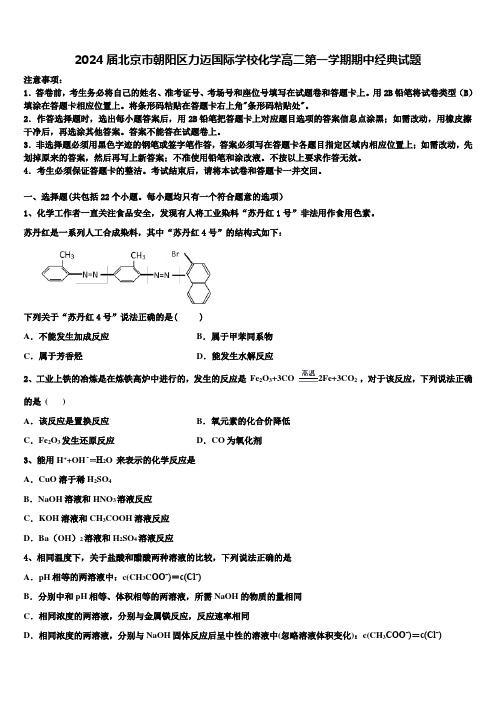
2024届北京市朝阳区力迈国际学校化学高二第一学期期中经典试题注意事项:1.答卷前,考生务必将自己的姓名、准考证号、考场号和座位号填写在试题卷和答题卡上。
用2B铅笔将试卷类型(B)填涂在答题卡相应位置上。
将条形码粘贴在答题卡右上角"条形码粘贴处"。
2.作答选择题时,选出每小题答案后,用2B铅笔把答题卡上对应题目选项的答案信息点涂黑;如需改动,用橡皮擦干净后,再选涂其他答案。
答案不能答在试题卷上。
3.非选择题必须用黑色字迹的钢笔或签字笔作答,答案必须写在答题卡各题目指定区域内相应位置上;如需改动,先划掉原来的答案,然后再写上新答案;不准使用铅笔和涂改液。
不按以上要求作答无效。
4.考生必须保证答题卡的整洁。
考试结束后,请将本试卷和答题卡一并交回。
一、选择题(共包括22个小题。
每小题均只有一个符合题意的选项)1、化学工作者一直关注食品安全,发现有人将工业染料“苏丹红1号”非法用作食用色素。
苏丹红是一系列人工合成染料,其中“苏丹红4号”的结构式如下:下列关于“苏丹红4号”说法正确的是( )A.不能发生加成反应B.属于甲苯同系物C.属于芳香烃D.能发生水解反应2、工业上铁的冶炼是在炼铁高炉中进行的,发生的反应是Fe2O3+3CO 2Fe+3CO2 ,对于该反应,下列说法正确的是( )A.该反应是置换反应B.氧元素的化合价降低C.Fe2O3发生还原反应D.CO为氧化剂3、能用H++OH﹣═H2O 来表示的化学反应是A.CuO溶于稀H2SO4B.NaOH溶液和HNO3溶液反应C.KOH溶液和CH3COOH溶液反应D.Ba(OH)2溶液和H2SO4溶液反应4、相同温度下,关于盐酸和醋酸两种溶液的比较,下列说法正确的是A.pH相等的两溶液中:c(CH3C OOˉ)=c(Clˉ)B.分别中和pH相等、体积相等的两溶液,所需NaOH的物质的量相同C.相同浓度的两溶液,分别与金属镁反应,反应速率相同D.相同浓度的两溶液,分别与NaOH固体反应后呈中性的溶液中(忽略溶液体积变化):c(CH3COOˉ)=c(Clˉ)5、已知原子的结构示意图为,下列说正确的是()A.该元素位于第3周期第ⅡA族B.该元素位于第2周期第Ⅷ族C.该元素位于第2周期第ⅡA族D.该元素位于第4周期第ⅡB族6、下列单质中,最容易与氢气发生反应的是()A.O2B.N2C.F2D.Cl27、β−月桂烯的结构如图所示,一分子该物质与两分子溴发生加成反应的产物(只考虑位置异构)理论上最多有()A.2种B.3种C.4种D.6种8、把1molA和3molB投入2L密闭容器中发生反应A(g)+3B(g)⇌2C(g)+D(s),2min后,测得C的浓度为0.2mol/L,则下列说法正确的是A.v(D)=0.05mol/(L•min)B.3v(B)=2v(C)C.v(B)=0.15mol/(L•min)D.A的转化率为40%9、关于平衡常数的说法中,正确的是()A.在平衡常数表达式中,反应物的浓度为初始浓度,生成物的浓度为平衡浓度B.在任何条件下,化学平衡常数都是一个恒定值C.平衡常数的大小只与浓度有关,与温度、压强、催化剂等无关D.从平衡常数的大小可以判断一个反应进行的程度10、下列变化过程,属于放热反应的是①金属钠与水②NH4Cl晶体与Ba(OH)2·8H2O混合搅拌③H2在Cl2中燃烧④液态水变成水蒸气⑤酸碱中和⑥碳酸钙热分解A.①②⑤B.①③⑤C.③④⑤D.②④⑥11、某反应的微观示意图如图所示,下列说法错误的是A.反应物中有单质B.生成物均是氧化物C.反应前是混合物,反应后是纯净物D.化学方程式是2H2S+3O2点燃2SO2+2H2O12、已知下列化合物:①硝基苯②环己烷③乙苯④溴苯⑤间二硝基苯。
2021-2022学年北京力迈学校高三化学测试题含解析

2021-2022学年北京力迈学校高三化学测试题含解析一、单选题(本大题共15个小题,每小题4分。
在每小题给出的四个选项中,只有一项符合题目要求,共60分。
)1. 化学反应中有很多反应都体现了“强制弱”的规律:比如强酸制弱酸;强氧化性的制弱氧化性的;强稳定性的制弱稳定性的;下列所呈现的反应没有体现这种规律的是:A.向硝酸银溶液中滴加氨水,先有白色沉淀,后白色沉淀消失。
B.使用惰性电极,电解饱和食盐水的过程C.将过量二氧化碳通入澄清的苯酚钠溶液中出现浑浊D.氢氧化铝溶于氢氧化钠溶液中参考答案:D略2. 下列变化或应用中,与分子间作用力有关的是()A.臭氧转变为氧气 B.工业生产中氯化钠晶体的熔化、冷却C.夏天马路洒水降温 D.日本大地震中用次氯酸溶液进行环境消毒参考答案:C略3. 下列各组中的反应,属于同一反应类型的是( )A.由溴丙烷水解制丙醇;由丙烯与水反应制丙醇B.由甲苯硝化制对硝基甲苯;由甲苯氧化制苯甲酸C.由氯代环己烷消去制环己烯;由丙烯加溴制二溴丙烷D.由乙酸和乙醇制乙酸乙酯;由苯甲酸乙酯水解制苯甲酸和乙醇参考答案:D略4. 下列图示与对应的叙述相符的是图Ⅰ图Ⅱ图Ⅲ图ⅣA.图Ⅰ表示H2与O2发生反应过程中的能量变化,则H2的燃烧热△H =-241.8 kJ·mol-1B.图Ⅱ表示反应A2 (g)+ 3B2 (g)2AB3(g),达到平衡时A2的转化率大小为:b>a>cC.图Ⅲ表示0.1mol MgCl2·6H2O在空气中充分加热时固体质量随时间的变化D.图Ⅳ表示常温下,稀释HA、HB两种酸的稀溶液时,溶液pH随加水量的变化,则NaA溶液的pH大于同浓度NaB溶液的pH参考答案:C试题分析:A.生成物水不是液态,不能表示氢气燃烧热,A错误;B.增加B2的浓度平衡向正反应方向进行,所以达到平衡时A2的转化率大小为:c>b>a,B错误;C.MgCl2为强酸弱碱盐,在空气中加热发生水解生成氧化镁,0.1molMgO的质量为0.1mol×(24+16)g/mol=4.0g,故最终生成质量应为4.0g,C正确;D.稀释HA、HB两种酸的稀溶液时,HA的pH变化大,这说明HA的酸性强于HB,所以NaA溶液的pH小于同浓度NaB溶液的pH,D错误,答案选C。
北京力迈学校高三化学联考试题含解析

北京力迈学校高三化学联考试题含解析一、单选题(本大题共15个小题,每小题4分。
在每小题给出的四个选项中,只有一项符合题目要求,共60分。
)1. 氢能是一种既高效又干净的新能源,发展前景良好,用氢作能源的燃料电池汽车倍受青眯。
我国拥有完全自主知识产权的氢燃料电池轿车“超越三号”,已达到世界先进水平,并加快向产业化的目标迈进。
氢能具有的优点包括( )。
①原料来源广②易燃烧、热值高③储存方便④制备工艺廉价易行A.①②B.①③C.③④D.②④参考答案:A氢能是易燃烧、热值高,原料来源广;但储存难、制备成本高,故①②正确。
2. 某溶液中含大量NH4+、Na+、HCO3-、CO32-、CH3COO-离子,其中加入足量的Na2O2固体后,溶液中离子浓度基本保持不变的是(假设溶液体积无变化)A.Na+ B.CO32-、NH4+ C.CH3COO-D.CH3COO-、Na+参考答案:C3. (08黄埔区4月模拟)阿伏加德罗常数约为6.02×1023mol-1,下列叙述正确的是()A.4 g重水(D2O)中所含中子数为0.2×6.02×1023B.1.4 g乙烯和丙烯的混合气体中所含氢原子数为0.2×6.02×1023C.4.48 L H2和O2的混合气体中所含分子数为0.2×6.02×1023D.0.1 molNa2O2溶解于足量的水中,转移电子数为0.2×6.02×1023参考答案:答案:B4. 常温下,下列各组离子在指定溶液中一定能大量共存的是A.1.0 mol·L-1的KNO3溶液:H+、Fe2+、Cl-、SO42-B.甲基橙呈红色的溶液:NH4+、Ba2+、AlO2-、Cl-C.pH=12的溶液:K+、Na+、CH3COO-、Br-D.与铝反应产生大量氢气的溶液:Na+、K+、CO32-、NO3-参考答案:C略5. 下列画有横线的物质在反应中不能完全消耗的是 ( )A.将含少量CO2的CO气体通入盛有足量Na2O2的密闭容器中,并不断用电火花引燃 B.将l mol Mg置于10 L空气(标况)中,使之在高温下反应C.标准状况下,将11.2L H2S与22.4L O2混合点燃D.在强光持续照射下,向过量的Ca(ClO)2上悬浊液中通入少量CO2参考答案:C略6. 关于下列各装置图的叙述中,错误的是()A.装置①是原电池,能将化学能转化为电能,锌电极发生氧化反应B.装置②可用于收集氨气,并吸收多余的氨气C.装置③中X若为四氯化碳,可用于吸收氨气或氯化氢,并防止倒吸D.若采用装置④精炼铜,则d极为粗铜,c极为纯铜,电解质溶液为CuSO4溶液参考答案:D7. 高铁酸钾可以制作可充电电池,该电池的工作原理为:3Zn+2K2FeO4+8H2O 3Zn(OH)2+2Fe(OH)3+4KOH,下列关于该电池的说法正确的是:A.在放电过程中,高铁酸钾被氧化B.在放电过程中,负极的电极反应为Zn+2OH-–2e- = Zn(OH)2C.充电时,电解质溶液的pH增大D.充电过程中,若生成1mol高铁酸钾,转移电子为6mol参考答案:B略8. 下列叙述合理的是:A.金属材料都是导体,非金属材料都是绝缘体B.棉、麻、丝、毛及合成纤维完全燃烧都只生成CO2和H2OC.酸性氧化物也叫对应酸的酸酐,酸酐都是酸性氧化物。
alevel化学书课后答案
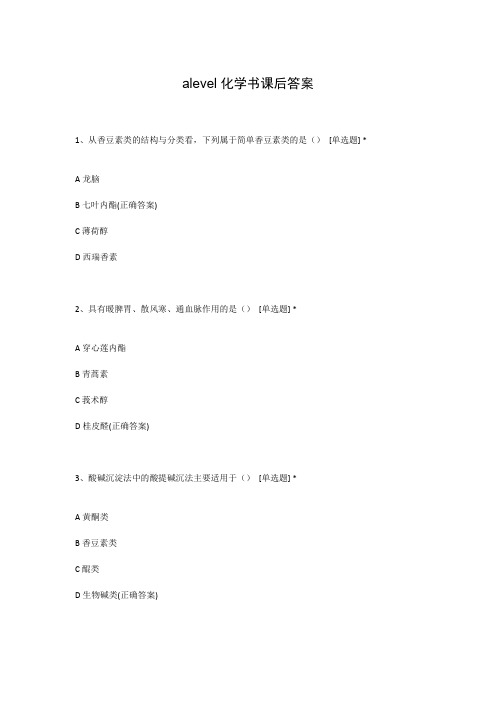
alevel化学书课后答案1、从香豆素类的结构与分类看,下列属于简单香豆素类的是()[单选题] * A龙脑B七叶内酯(正确答案)C薄荷醇D西瑞香素2、具有暖脾胃、散风寒、通血脉作用的是()[单选题] *A穿心莲内酯B青蒿素C莪术醇D桂皮醛(正确答案)3、酸碱沉淀法中的酸提碱沉法主要适用于()[单选题] *A黄酮类B香豆素类C醌类D生物碱类(正确答案)4、以下哪种方法是利用成分可以直接由固态加热变为气态的原理()A [单选题] * A升华法(正确答案)B分馏法C沉淀法D透析法5、七叶内酯的结构类型为()[单选题] *A简单香豆素(正确答案)B简单木脂素C呋喃香豆素D异香豆素6、组成缩合鞣质的基本单元是()[单选题] *A黄烷-3-醇(正确答案)B酚羟基C环戊烷D哌啶环7、牛蒡子属于()[单选题] *A香豆素类B木脂内酯(正确答案)C苯丙酸类D黄酮类8、游离生物碱和生物碱盐都易溶解的溶剂是()[单选题] * A三氯甲烷B正丁醇C乙醇(正确答案)D水9、能影响黄酮类成分的溶解性的因素有(多选)()*A黄酮的类型(正确答案)B苷元上取代基的种类、数目和位置(正确答案)C糖基的数目和位置(正确答案)D分子立体结构(正确答案)10、挥发油的溶解性难溶于()[单选题] *A水(正确答案)B乙醇C石油醚D乙醚11、薄层吸附色谱中的Rf的大小说明了吸附程度的大小,吸附力越大,则Rf()[单选题] *A越大B越小(正确答案)C越接近1D越接近012、区别挥发油与油脂常用的方法是()[单选题] *A相对密度B溶解性C油迹试验(正确答案)D沸点13、有机溶剂加热提取中药成分应采用()[单选题] *A回流装置(正确答案)B蒸馏装置C萃取装置D分馏装置14、中药厚朴中含有的厚朴酚是()[单选题] *A双环氧木脂素类B联苯环辛烯型木脂素类C环木脂内酯木脂素类D新木脂素类(正确答案)15、从香豆素类的结构看,香豆素是一种()[单选题] *A内酯(正确答案)B羧酸C酰胺D糖16、下列方法哪一个不是按照色谱法的分离原理不同进行分类的是()[单选题] * A离子交换色谱B薄层吸附色谱(正确答案)C凝胶色谱D分配色谱17、乙醇不能提取出的成分类型是()[单选题] *A生物碱B苷C多糖D鞣质(正确答案)18、水蛭的主要化学成分是()[单选题] *A有机酸B蛋白质(正确答案)C多糖D生物碱19、容易发霉变质的是()[单选题] *A中药水提取液(正确答案)B中药乙醇提取液C二者均是D二者均非20、颜色随pH值不同而变化的是()[单选题] * A黄酮B花青素(正确答案)C二氢黄酮D查耳酮21、下列方法中哪一个不是按照色谱法的操作形式不同而进行分类的()[单选题] * A离子交换色谱(正确答案)B薄层吸附色谱C纸色谱D吸附柱色谱22、在简单萃取法中,一般萃取几次即可()[单选题] *A3~4次(正确答案)B1~2次C4~5次D3~7次23、与水不分层的溶剂是()[单选题] *A正丁醇B石油醚C三氯甲烷D丙酮(正确答案)24、具有挥发性的香豆素成分是()[单选题] *A游离小分子简单香豆素(正确答案)B香豆素苷C呋喃香豆素D双香豆素25、中药紫草中的主要有效成分属于()[单选题] * A苯醌类B萘醌类(正确答案)C蒽醌类D菲醌类26、检识黄酮类化合物首选()[单选题] *A盐酸-镁粉反应(正确答案)B四氢硼钠反应C硼酸显色反应D锆盐-枸橼酸反应27、下列生物碱碱性最强的是()[单选题] * APkA=22BPkA=5(正确答案)CPkA=13DPkA=5828、以葛根素为指标成分进行定性鉴别的中药是()[单选题] * A葛根(正确答案)B黄芩C槐花D陈皮29、醇提醚沉法主要适用于以下的哪一类成分()[单选题] * A多糖B叶绿素C皂苷(正确答案)D黏液质30、萜类化合物在化学结构上的明显区别是()[单选题] *A氮原子数不同B碳原子数不同(正确答案)C碳环数不同D硫原子数不同。
- 1、下载文档前请自行甄别文档内容的完整性,平台不提供额外的编辑、内容补充、找答案等附加服务。
- 2、"仅部分预览"的文档,不可在线预览部分如存在完整性等问题,可反馈申请退款(可完整预览的文档不适用该条件!)。
- 3、如文档侵犯您的权益,请联系客服反馈,我们会尽快为您处理(人工客服工作时间:9:00-18:30)。
For Examiner's
Use
(ii) The bond energy of the Si-Br bond is 298 kJ mol-1. Use this value, and other bond energy values given in the Data Booklet to suggest whether the reaction between
READ THESE INSTRUCTIONS FIRST
Write your Centre number, candidate number and name on all the work you hand in. Write in dark blue or black pen. You may use a soft pencil for any diagrams, graphs or rough working. Do not use staples, paper clips, highlighters, glue or correction fluid.
[2] (c) (i) Hence calculate the average bond energy of the Si-Cl bond from these data.
(ii) Suggest why the calculated value is different from the value given in the Data Booklet.
[5] [Total : 10]
SP/QP/9701/04
3
For
Examiner's
Use
© P07
[Turn over
4 2 (a) Define the standard enthalpy change of formation of a compound.
(ii) Write a simple equation relating the rate of reaction to the concentration of bromine under these conditions.
(iii) Calculate the half-life of this reaction.
(a) (i) What maximum volume of gas, measured at r.t.p., would be produced by reacting 3.2 g of bromine?
For Examiner's
Use
(ii) Suggest how the rate of the reaction might be followed.
© UCLES 2006
9701/04/SP07
[Turn over
6
3 Agricultural lime is manufactured from limestone (calcium carbonate) by first heating the rock to a high temperature in a lime kiln. The product is allowed to cool and a calculated amount of water is added. A highly exothermic reaction takes place and a white powder called ‘slaked lime’ is produced.
½X2(aq)/X -(aq), where X = Cl, Br, I. Use relevant data from the Data Booklet to describe and explain each of the following. Give an equation for each reaction that occurs.
For Examiner's
Use
[4] (c) (i) Write equations to show the reactions that occur when dilute ammonia solution is
slowly added to a solution of CuCl2 until the ammonia is in excess.
For Examiner's
Use
[2]
The standard enthalpy change of formation of SiCl4(g) is –610 kJ mol-1. The standard enthalpy changes of atomisation of the elements silicon and chlorine are +338 and +122 kJ mol-1 of atoms respectively. (b) Use these values to construct an energy cycle to show the formation of SiCl4(g).
UCLES 2006
This document consists of 17 printed pages and 1 blank page.
[Turn over
2
Section A Answer all the questions in the spaces provided.
1 Bromine can react with methanoic acid according to the following equation. Br2(aq) + HCO2H(aq) → 2Br-(aq) + 2H+(aq) + CO2(g)
SiBr3H and hydrogen would be more or less endothermic than the reaction between SiCl3H and hydrogen.
(iii) State a use of pure silicon.
[4] [Total : 10]
Section A Answer all questions.
Section B Answer all questions.
You may lose marks if you do not show your workings or if you do not use appropriate units. At the end of the examination, fasten all your work securely together. The number of marks is given in brackets [ ] at the end of each question or part question.
[3] (d) The mineral dolomite is a double carbonate of magnesium and calcium, with the
formula CaMg(CO3)2. When 1.000 g of an impure sample of dolomite was completely dissolved in an excess of hydrochloric acid, 0.450 g of carbon dioxide was given off. (i) Write a balanced equation for the reaction.
(a) Write balanced equations for these two reactions.
For Examiner's
Use
[2] (b) Give two reasons why lime is used in agriculture.
[2]
(c) How does the temperature required to decompose the carbonates of Group II elements vary down the group, and why is this so?
[2]
UCLES 2006
9701/04/SP07
5 (d) Pure silicon is made by reducing SiCl3H with hydrogen at a high temperature.
(i) Construct a balanced equation for this reaction.
(ii) What type of chemical reaction is occurring? Explain your answer.
[4] [Total: 10]
© UCLES 2006
9701/04/SP07
[Turn over
8
5 The elements in Group VII show trends in a number of their physical and chemical properties.
Centre Number
Candidate Number Name
UNIVERSITY OF CAMBRIDGE INTERNATIONAL EXAMINATIONS General Certificate of Education
Advanced Subsidiary Level and Advanced Level
(ii) Calculate the percentage purity of the dolomite.
[3] [Total : 10]
UCLES 2006
9701/04/SP07
